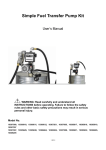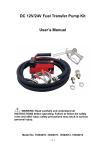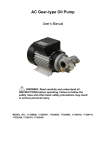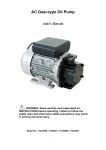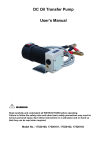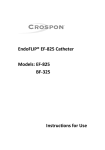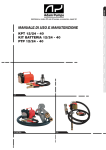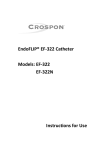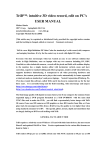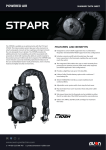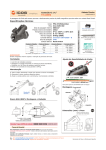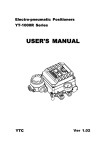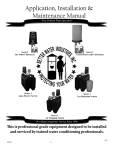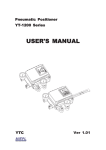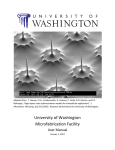Download Fuel Transfer Pump Kits - Folke
Transcript
Fuel Transfer Pump Kits User’s Manual WARNING: Read carefully and understand all INSTRUCTIONS before operating. Failure to follow the safety rules and other basic safety precautions may result in serious personal injury. Model No. 10305601, 10307202, 10308001, 10305602, 10307203, 10308002, 10306602, 10308202, 10306603, 10308203, 10305627, 10305628, 10307006 1 OF 8 A. DECLARATION OF CONFORMITY DECLARATION OF CONFORMITY IN ACCORDANCE WITH THE DIRECTIVES: 89/392/CEE - 91/368/CEE - 93/44/CEE – 89/336/CEE – 92/31/CEE THE MANUFACTURER: INTRADIN (SHANGHAI) MACHINERY 118 DUHUI ROAD, MINHANG DISTRICT, SHANGHAI, 201109 CHINA DECLARES THAT THE FOLLOWING PUMP MODELS: 10305601, 10307202, 10308001, 10305602, 10307203, 10308002, 10306602, 10308202, 10306603, 10308203, 10305627, 10305628, 10307006 To which this declaration refers, conform to the following applicable regulations: EUROPEAN REGULATIONS: EN292-1-92 – Safety of Machinery – General Concepts, basic principles for design – terminology, basic methodology EN292-2-92 – Safety of Machinery – General Concepts, basic principles for design – specifications and technical principles EN294-93 – Safety of Machinery – safe distances to prevent the operator’s upper limbs from reaching dangerous areas EN60034-1-2000 – Rotating electrical Machinery – nominal and functional specifications EN60034-5-2001 – Classification of grades of protection for the housings of rotating electrical machinery EN61000-6-3 – Electro – magnetic compatibility – generic emission standards EN61000-6-1 – Electro – magnetic compatibility – generic immunity standards EN55014-1-00(A1/99-A2/99) limits and methods for measuring radio disturbance characteristics EN55014-2-97 – Electrical motor – operated and thermal appliances for household and similar purposes, electric tools and similar electrical apparatus EN60204-1-98 –safety of machinery – electrical equipment of machines B. INTRODUCTION The diesel transfer pump kits have been designed for the delivery of diesel or kerosene from an open surface tank. This manual, apart from giving all necessary information on ordinary maintenance and supporting engineers in failure detection and repair, should also give all the information’s needed to fully employ the capacity of the machine, as well as to the user’s needs. C. INSTALLATION Electric connection should be done on a CEI standard socket provided with switch (so it isn’t live when the connection is done) according to L.46/90 prescriptions. PRELIMINARY INSPECTIONS Before the power connection is done, verify the conductors aren’t live and general switches are off. 2 OF 8 DISMANTLING AND DISPOSAL PROCEDURE The metallic parts which the machine is mainly made of will be dismantled and sent to the steel mills. The fuels in the tanks of the installation will be collected and sent to an authorized disposer. All plastic and non-degradable material parts will be separately collected and sent to an authorized disposer or recycled. SAFETY DEVICES z General Switch It is placed on the motor body and allows the operator to set it on standby in a very short time. Once the machine is stopped, the whole starting procedure can be repeated. z Mechanical Protections They are metal protections meant to prevent access to mechanical moving parts, high-temperature parts and live electric parts. z Harmful Functions The noise from the machine is below 70 dB (A). z FIRE PREVENTION In case of fire never use water, but extinguishing powders charged with CO2 cat. A-B-C-D only, employing the extinguishers placed next to the machine. Combustion of paints and plastic parts may produce toxic emissions (always refer to the security supervisor of the place of installation). z FOR DC PUMPS ATTENTION! 1. Extreme operating conditions with working cycles longer than 30 minutes can cause the motor temperature to rise, thus damaging the motor itself. 2. Each 30-minute working cycle should always be followed by a 30-minute power-off cooling phase. 3. MAXIMUM BY-PASSING TIME: 3 MINUTES. 4. DO NOT RUN DRY OVER 30 SECONDS. NOTICE: THE VISION IS BUILT PAYING MAXIMUM CARE TO USER’S AND MAINTENANCE ENGINEER’S SECURITY. D. TECHNICAL DATA MODEL Flow Rate ELECTRICAL POWER Model of Meter Current Voltage(V) Power 10305601 56LPM/15GPM 15111200 AC 230V 370W 10307202 72LPM/19GPM 15111200 AC 230V 450w 10308001 80LPM/22GPM 15111200 AC 230V 450w 10306602 66LPM/18GPM 15111200 AC 120V 370W 10308202 80LPM/22GPM 15111200 AC 120V 450w 10305602 56LPM/15GPM Not included AC 230V 370W 10307203 72LPM/19GPM Not included AC 230V 450w 10308002 80LPM/22GPM Not included AC 230V 450w 10306603 66LPM/18GPM Not included AC 120V 450w 3 OF 8 10308203 80LPM/22GPM Not included AC 120V 370W 10305627 56LPM/15GPM Not included DC 12V / 10305628 56LPM/15GPM Not included DC 24V / 10307006 35/70LPM 9/18PM Not included DC 12/24V / E. PRECAUTIONS During Diesel delivery always wear fuel resistant gloves and always wash hands with water and soap at the end. Always clean at once fuel stains to avoid slips and/or pollution. Use particular care with the zones next to the controls. When cleaning, and specially when removing dust or waste, always wear suitable clothes, if possible use aspirators only. Always use suitable clothes or protective devices. Never place hands or limbs under moving parts. F. SYSTEM DESCRIPTION Functional Description The diesel transfer system are hydraulic machine tools which feed with a given capacity (volume) of fluid in the time unit, a collecting tank, sucking the liquid from an open surface feed tank; the allowed suction lift (geodetic suction lift Hga) is also a specific characteristic of the pump. The system is composed by complementary equipment, operating as whole to give a complete service: z Feeding pump z Volumetric flow meter (Optional) z Suction filter z 4M (13.5ft.) Delivery rubber hose z Manual dispensing nozzle MACHINE DESCRIPTION The diesel transfer unit has been designed and built according to the following standards: z Electric requirements: EN 60204-1 and EN 60529 z Mechanical requirements: EN 292-1 and EN 292-2; EN 55081-2, EN 55011C/A z Other requirements 89/392 CEE G. ALLOWED AND FORBIDDEN USE This fuel transfer unit has been designed and built for DIESEL & KEROSENE TRANSFER ONLY from reservoirs, tanks and drums. It is strictly forbidden to employ it to transfer liquids of different kind as gasoline, explosives and corrosives (or flammable), alimentary liquids. The machine isn’t designed for employment in the explosive environment. Operating the pump is forbidden to children and disabled person. It is forbidden to employ the unit next to flammable liquids (gasoline, alcohol, etc.). It is forbidden the employment in closed environments in presence of gasoline, LPG, methane fuelled vehicles. 4 OF 8 H. TRANSPORT AND UNPACKING Due to its weight and dimensions, the unit can easily be transported by hand. Control that the package is good conditions and verify that the unit isn’t damaged. Each failure must be noticed in 10 days from receiving the machine. For correct unpacking carefully follow these instructions: 1. Place the case on the ground following the indications on the package. 2. Carefully open the case, remove the machine and place it on the ground or on a steady surface. 3. Control that the machine and its accessories aren’t damaged. 4. Fasten the panel, placing it on the ground or on a steady surface capable of carrying the pump, in a repaired environment with a temperature between +40℃ and -20℃ well lit and ventilated. For a better employment the unit should be placed as near as possible to level of liquid to be pumped. (Max. distance 2m) 5. Screw the delivery hose on the fitting of the flow meter and of the filling gun. 6. We suggest using a diesel oil resistant rubber or plastic suction hose; spiral shaped, with minimum as 1” internal diameter, the same as the union. The hose must be sealed to avoid oil leaks. In case a 4M/13.5ft. or longer hose is employed we suggest to use the foot valve with filter. I. USE AND STARTING POWER GRID ELECTRICAL CONNECTION The plant must be provided with a safety device of 30mA minimum Din standard. The plug must be connected to an earthed SHUKO socket. It is forbidden to cut or replace the provided plug. STARTING Once the hoses are sealed, the feeding cable is connected and the filling gun is in rest position, the machine can be started. After placing the hose into the tank and the gun into the filling hole, start the pump, gradually release the lever and start Diesel oil transfer. Once the filling is done release the control of the gun and switch the pump off. When the pump isn’t in use disconnect it. FLOW METER (Optional) The follow meter shows how many litres of liquid were pumped by the unit. Be aware that this device is not suitable to measure products for resale. The mechanical flow meters indicate the partial (resettable) and total (no reset function) of the litres pumped. Each time the instrument must be reset, turn the knob on the left of the unit until all zeroes are displayed. Calibration The meter used in the pumping unit is calibrated at the factory. Calibration is recommended upon initial use, after disassembly or significant wear. Meter calibration can be easily changed with the procedure hereafter. The proving container should be at least 50 litre / 13 gallon. Procedure: Fill container to a know volume Turn the calibration screw +Clockwise to increase the number of liters counted -Counterclockwise to decrease the number of liters counted 5 OF 8 WARNINGS 1. The gunlock has been provided to make filling easier. It is forbidden to leave the gun unattended to avoid oil overflow. 2. Don’t operate the machine if there is no liquid inside. Don’t start the pump before connecting suction and delivery hoses. 3. Once the gun is closed, switch the motor pump off as soon as possible. THE PUMP HAS TO WORK IN BY-PASS CONDITION FOR SHORT PERIOD: MAXIMUM 3 MINUTES. 4. In case of current losses the pump should be switched off and the plug disconnected. 5. It is strictly forbidden to use the pump with wet hands, barefooted or dipped in water. 6. In case of blackout switch the pump off and disconnect the plug to avoid unexpected starts with liquid overflow. 7. When transferring from open-air tanks, we suggest to place the machine as far as possible to avoid sprays and sudden dips which may cause serious damage. J. MAINTENANCE Each kind of disassembly should always be carried out when the machine is stopped, the plug is disconnected and after emptying the pump and the flow meter. For a better operation control every three months that there isn’t any kind of debris in the flow meter filter. K. OPERATIONAL PROBLEMS ACCIDENTS The pump work doesn’t CAUSES A) Jammed shaft B) No electric feeding REMEDIES A) B) Disconnected the plug; unscrew on the pump, remove the pump body and clean it inside. Control that the shaft is now working correctly. Reassemble the pump. Control that the plug is correctly connected and that the socket is live. The pump works doesn’t deliver liquid. The pump sucks air from the suction hose. Control the suction hose seal on the pump. Verify that the hose is completely immersed into the liquid and free from chokes. Control that the filter is clean. Remember that the pump can suck up to 4 meters. The pump works but the flow meter doesn’t measure Dirt inside the flow meter chamber Disconnected the plug. Using the flow meter exploded view as a guide disassembles the faceplate and the assembly support. Open the chamber and carefully clean the revolving disk. Reassemble. L. MECHANICAL RISKS 1. Mechanical parts subject to wear The blades The bearing The rotor These parts should be replaced with original spare parts by qualified personal only or in authorized service centres. 6 OF 8 Risks due to extreme temperatures Remember that a very low temperature can freeze the Diesel oil inside the pump. This situation can cause serious damage to the motor pump unit. A very high temperature (about 45℃) may cause the plastic parts in the unit to expand. The unit should thus be placed in a well-ventilated place and protected from the sun. M. DIAGRAM Units with meter Units without meter N. PARTS LIST Units with meter Part No. Component description Quantity 1 Screw M6 4 2 Fuel transfer pump 1 3 O-ring 1 4 Outlet 1 7 OF 8 5 Mechanical Meter 1 6 Screw M8 2 7 Elbow 1 8 Screw M8 4 9 Manual Nozzle 1 10 Housing 1 11 Screw M6 4 12 Washer 4 13 Valve 1 14 Filter 1 15 Inlet 1 16 Fitting 1 Part No. Component description Quantity 1 Inlet 1 2 Screw M6 4 3 Fuel transfer pump 1 4 Manual Nozzle 1 5 Outlet 4 6 Elbow 1 7 Housing 1 8 Screw M6 4 9 Washer 4 10 Fitting 1 11 Valve 1 12 Filter 1 Unit without meter 8 OF 8








